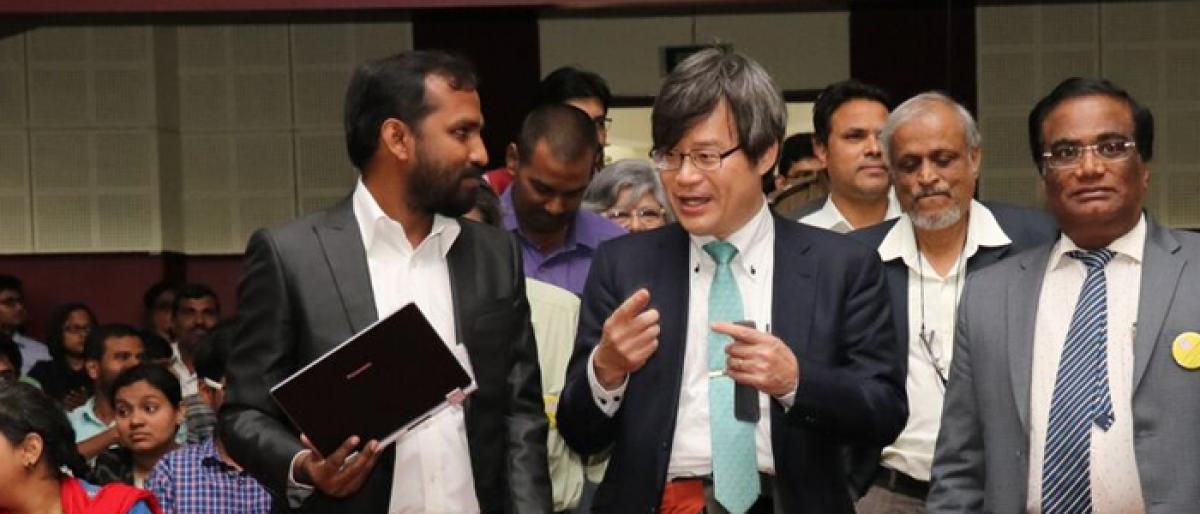Live
- WhatsApp will leave India, if asked to break encryption
- SC rejects pleas on 100% cross VVPAT verification
- Razole: Ample scope for tourism promotion in Konaseema says Pawan Kalyan
- KCR hand in glove with BJP: Revanth
- Kaleshwaram Irregularities: Ghose Commission to dig deep to find flaws
- Kudos to young boy: Saichand’s timely action saves trapped workers
- MyVoice: Views of our readers 27th April 2024
- WHO launches first ever Patient Safety Rights Charter
- Guntur: Narendra Modi to campaign in Andhra Pradesh on May 7,8
- Lower Voter Turnout: ‘400 paar’ looks remote for NDA
Just In

Nobel laureate Prof Hiroshi Amano stressed on the need to make the technologies more cost-effective while describing the state of technology in the fabrication of small and efficient LEDs for display applications.
Hyderabad: Nobel laureate Prof Hiroshi Amano stressed on the need to make the technologies more cost-effective while describing the state of technology in the fabrication of small and efficient LEDs for display applications.
The Nobel Laureate in Physics for the year 2014 delivered a lecture on “Blue LED and Transformative Electronics for Developing Sustainable Smart Society”, as part of the Hyderabad Lecture Series, supported by the Insurance Regulatory and Development Authority (IRDA) at the University of Hyderabad, here on Wednesday.
Outlining how the Gallium Nitride-based Ultraviolet sources technology have helped in water purification, he further explained, how Gallium Nitride-based devices will play a big role in the Internet of Things (IoT), 5G communications and Internet of Energy which will include wireless powering of devices over 10s of meters.
Prof Amano outlined the state of technology in the fabrication of small and efficient LEDs for display applications. Most researchers have given up on the fabrication of the Gallium Nitride LED, because of large lattice mismatch between Gallium Nitride and Sapphire substrate by using a buffer layer. This solved a long-standing challenge in creating a Blue LEDs and thereon to white LED. It was for which, Prof Amano had received the Nobel Prize in 2014, along with I Akasaki and S Nakamura.
He said that the white LED, using the new discovery had revolutionised display and energy efficient technologies. He also pointed out how this technology can meet the needs of smart and sustainable technologies.
About one-fourth of world’s electricity consumption is used for lighting purposes. The LEDs contribute in a very big way to saving the Earth's resources. Because the LEDs last up to 1, 00,000 hours, compared to 1,000 hours for incandescent bulbs and 10,000 hours for fluorescent lights. This led to the reduction of the materials consumption.
Also, the LED lamp holds great promise for increasing the quality of life for over 1.5 billion people around the world, who lack access to electricity grids. This is possible due to its low power requirements which can easily be powered by cheap local solar power. The invention of the efficient blue LED is just twenty years old, but it has already contributed to creating white light in an entirely new manner to the benefit of mankind.
The Lecture was presided over by Prof Appa Rao Podile, Vice-Chancellor of UoH and attended by many students and academicians from the twin cities including Vice-Chancellor of Osmania University, Prof S Ramachandram, Nilesh Sathe, Member (Life) from IRDAI along with his colleagues. Students from few schools also attended. Prof Bindu A Bambah, Dean, School of Physics at UoH introduced the speaker while Prof S Srinath from School of Physics proposed the vote of thanks. It was followed by an interactive session with students and faculty of the University.

© 2024 Hyderabad Media House Limited/The Hans India. All rights reserved. Powered by hocalwire.com







